How to turn data into personalised customer experiences with categorisation

Today’s banking apps create the most value for customers when providing easy-to-use solutions to their problems. This means that turning consumer transaction data into innovative digital banking solutions is a must. But the first step is making sense of this data – by cleaning and categorising it. Here’s how Tink’s categorisation capability can help.
Cleaning and categorising transaction data is key to building personalised digital banking experiences that keep people coming back.
Tink’s categorisation helps banks create banking apps that engage customers – and is a building block for Tink Data Enrichment.
Tink Data Enrichment is the ideal engine to power your personal finance management services and coach customers towards financial wellness.
Building innovative features into digital banking solutions is essential to better support customers with user-friendly solutions that bring value to them. These features are built on transaction data from consumers. But in order to build from this data, the transactions first need to be cleaned and categorised. An essential part of any digital solution engine is therefore heavily dependent on the transaction categorisation.
What is transaction categorisation?
Transaction data is generated every time money transfers between two entities, i.e. when a person makes a transaction (for example, making a purchase, withdrawing money or receiving income of any kind). This transaction data consists of a date, the transaction amount and description – along with a lot of clutter and disturbance.
This raw data transaction is then cleaned up and processed to identify its purpose and context – based on the description, amount and date. In other words, being categorised.
The cleaned transactions are then grouped into specific categories that help interpret consumers’ spending habits, patterns and the amount that is spent on different things. For instance, identifying transport expenses such as taxis or public transport, visits to restaurants and bars, utility expenses and so on.

A raw transaction is cleaned and categorised before being displayed to a user in their banking app. Banks can then continue building features that offer, for example, advice on creating budgets for top expenses/categories
Based on machine learning
Tink’s categorisation is based on machine-learning models that identify and categorise transactions, with user preferences being learned and applied. In addition, transactions can also be manually re-categorised to better fit the user’s preferences.
By using machine-learning models, rather than simply a rule-based model, the categorisation becomes more accurate. As the models leverage global data sets and text-processing algorithms, they learn how to classify transactions accurately. In time, categorisation also gets smarter, refining its ability to adapt to a customer’s preferences.
Unlike a rule-based system, machine learning can also categorise transactions it’s never seen. It does this by taking the data from that transaction – and others – to determine the probability of a transaction belonging to a particular category. Then we apply a user’s preferences for certain transactions. For example, they might eat at the same pub for lunch every week, so for them that transaction falls under ‘restaurant’, not ‘bar’. And so it goes for every transaction passing through our platform – about 10 million per day.

A combination of machine-learning models identifies a category for each transaction. Specific preferences are then learned and applied, personalising the user’s experience. Users can also re-categorise transactions into the category they feel fits their purpose best.
How do businesses benefit?
Machine-learning intelligence
Machine learning consisting of a combination of four predictive components, based on multiple transaction featuresUser feedback loop
The categorisation accuracy on market level, and personalised categorisation model, is improved through using a user feedback loopTransfer detection
Incoming and outgoing transfers are detected on all aggregated accountsCoverage across 18 markets
Our taxonomy is valid across 18 markets with market-level optimisationsImproved user experience and engagement
Categorisation boosts the user experience by enabling a better view of customers’ finances. In addition, allowing users to re-categorise their transactions can also boost user engagement.
How do consumers benefit?
Better understanding of personal finances
By viewing which categories receive the most funds, it’s easy for customers to see where their money goes each month and adjust spending habitsAutomatically organised spending
Spending is categorised automatically through machine learning, making it easy for customers to track spendingA personal touch
Transactions can also be manually re-categorised to best suit the consumer’s preferencesFinancial advice
With categorisation in place, banks can continue building on it and offer advice on, for example, setting up a budget for specific categories where their customer spends the most amount of money.
In short, Tink’s categorisation model can be used to process account information from several different transaction sources, including open banking data, different types of card transactions and more.
Categorisation is more than just organising transactions – it creates a base for businesses to understand financial transactions and better cater to the needs of their customers. All this while offering the customer a better experience, and deeper understanding of their spending habits.
Categorisation is a core building block in Tink’s Data Enrichment product. Interested in learning how open banking powered features like this help you create better customer experiences? Get in touch.
All brand names, logos and/or trademarks are the property of their respective owners, are used for identification purposes only, and do not necessarily imply product endorsement or affiliation with Visa.
More in Open banking

2025-11-20
3 min read
Tink powers the UK’s first cVRP transaction with Visa A2A
In partnership with Visa, Kroo Bank, and Utilita, we’ve just helped demonstrate the UK’s first commercial variable recurring payment (cVRP) using the Visa A2A solution – and it’s a big step forward for how people make regular payments.
Read more

2025-06-09
11 min read
The case for “Pay by Bank” as a global term
Thomas Gmelch argues that "Pay by Bank" should be adopted as a standard term for open banking-powered account-to-account payments to reduce confusion, build trust, and boost adoption across the industry.
Read more

2025-06-02
3 min read
Tink joins Visa A2A – what it means for Pay by Bank and VRP
Visa A2A brings an enhanced framework to Pay by Bank and variable recurring payments (VRP) in the UK, and Tink is excited to be one of the first members of this new solution.
Read more
Get started with Tink
Contact our team to learn more about what we can help you build – or create an account to get started right away.
